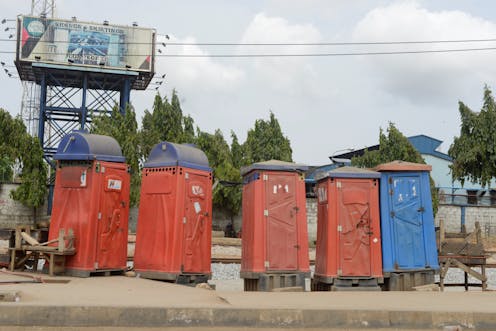
Nigeria’s coastal areas are known to present environmental hazards and risks. Oil exploration and exploitation is one source of these hazards. Oil spillage, gas flaring, air and water pollution and agricultural land contamination are serious problems in the region, with implications for human and environmental health.
Flooding and erosion are additional sources of danger in the region. Damage from floods is extensive.
Poor sanitation is a third hazard. Poor sanitation practices, poor location of facilities like toilets and kitchens, and the contamination of water sources in oil producing communities expose residents to cholera, typhoid, malaria and dysentery.
Residents’ perceptions of the environmental hazards have not been well explored. It’s important to understand perceptions because they drive behaviour. In looking for ways to avoid, prepare for and respond to hazards and disasters, it is useful to understand what motivates people’s actions.
Research has shown that people take action on threats based on their personal perception of the risk. Perception, in turn, depends on the level of information people have about the risk, personal experience of past events and socioeconomic attributes. It’s also influenced by the quantity of losses people think they can avoid, absorb and tolerate. The type of hazard makes a difference. So does people’s trust in the capability of authorities.
Therefore, in our study we sought to understand what influences the perceptions of people in Delta State when it comes to environmental risks. Understanding what drives their actions could help in finding ways to avoid or cope with risks and disasters.
We found that residents were less concerned about oil induced hazards and risks, or floods and erosion, than they were about the lack of sanitation amenities like drains and toilets. They perceived oil and flood risks as normal parts of their lives, not as major risks. Some even contributed to those problems by, for example, stealing oil.
What they were most worried about was being vulnerable to things like snakebites, reptile invasion, storm water diversion into their homes, collapse of buildings, spread of diseases from open defecation, and personal safety related to bathrooms and kitchens being located away from homes.
Many of the residential areas in the region have evolved without planning regulations. Residents haven’t always followed safe practices when building amenities. The resulting danger is an unsanitary environment. We suggest that government agencies ensure house owners adhere to building codes.
Study of coastal towns
Our research was carried out in the southern part of Nigeria over 18 months. We focused on three towns: Sapele, Oghara and Koko. The towns are involved in crude oil activities and are close to the ocean. They also face dangers from toxic waste dumping.
In these towns, infrastructure such as roads, drainage and public toilets is inadequate and in very poor condition.
We sampled residential buildings from each town and gave questionnaires to 218 residents of these buildings. The questionnaire aimed to capture the socio-economic attributes of the people and their awareness of environmental hazards such as oil and sanitation. It also asked about the severity attached to risk emanating from hazards and responses to them.
Previous research has found that people’s perceptions of environmental hazards and risks are influenced by socioeconomic characteristics and by environmental awareness. The presence of amenities such as well-lit and tarred roads, location of emergency management agencies, electricity transformers and fire stations has also been found to be related to perceptions. We examined the impact of these factors on the way our respondents viewed environmental hazards and risks.
What influences perceptions
We found that a direct relationship exists between residents’ perception of environmental threats and infrastructure availability. Such infrastructure includes roads, drainage, public toilets, health centres, schools and electricity transformers.
The availability and location of toilets and drains scored highest among residents’ concerns. Location of kitchens was another issue. In most cases, toilets, bathrooms and kitchens are constructed detached from the main buildings, making residents more vulnerable to health risks. Such kitchens are vulnerable to infestation by flies, ants, cockroaches and other disease vectors.
We also discovered that people’s views have no relationship with efforts by the government, international oil companies and nongovernmental organisations to address threats. Such threats include oil pollution, gas flaring, hazardous waste, odour and erosion. This implies that people do not trust the capacities of these stakeholders to manage environmental hazards. They therefore engage in environmentally destructive and defiant behaviours such as crude oil theft, illegal oil refining and pipeline vandalism.
Read more: Three things that can go wrong at an illegal oil refinery in Nigeria
The socioeconomic attributes of residents correlated with their views on environmental threats. These are attributes such as gender, age, educational status, household size, income, occupation and length of stay in the area.
Higher income, higher level of education, and longer length of stay increased concerns about environmental threats. This shows that the more people’s income and education level are enhanced, the more concerned they are about managing environmental hazards in their area.
The way forward
We recommend ways to enhance people’s perception of environmental hazards – and thus enhance safety practices.
Governments at all levels should improve the provision and maintenance of environmental amenities.
Government should also work with representatives of the people to effectively monitor and manage threats emanating from oil production activities. The key involvement of the representatives will instil trust and create a sense of belonging in the efforts to manage the threats.
Government and NGOs should provide environmental education for residents of the coastal towns. Residents need to know about the inherent harmful impacts of unsanitary environments and poor amenities. Education could be done through the media and the school curriculum.
Seun Olowoporoku does not work for, consult, own shares in or receive funding from any company or organisation that would benefit from this article, and has disclosed no relevant affiliations beyond their academic appointment.
This article was originally published on The Conversation. Read the original article.







